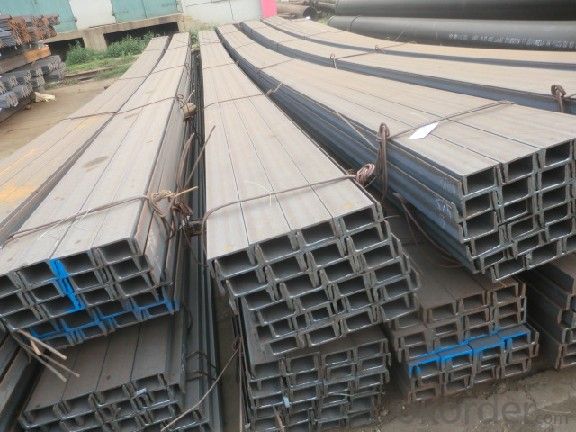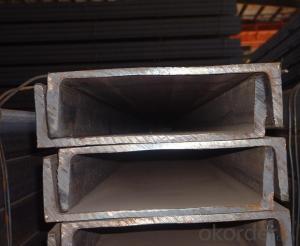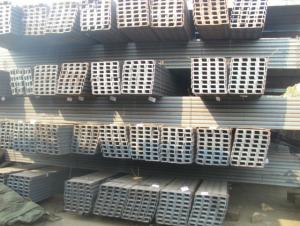hot channle and gb
- Loading Port:
- China Main Port
- Payment Terms:
- TT OR LC
- Min Order Qty:
- -
- Supply Capability:
- -
OKorder Service Pledge
OKorder Financial Service
You Might Also Like
Product Description:
Specifications of MS Channel:
1.We supply high quality MS Channel at reasonable price, including Chinese standard, Japanese standard and so on.
Standard | GB/JIS |
Material Grade | Q235,SS400 |
Technique: | Hot Rolled |
Sizes as per chinese standard: | 50*37*4.5mm - 300*89*11.5mm |
Sizes as per japanese standard: | 50*25*3mm – 200*80*7.5mm |
Length: | 6meter, 9meter, 12meter |
Note: 1.we are also competent to provide our customers other MS Channel based on other sizes according to customer’s requirements.
2. The length of our ms channel could be cut into other meters as per customer’s requirements. For example, the channel in 6meters could be cut into 5.8meters in order to be fit in the 20ft container.
2. The detailed sections of MS Channel as per GB standard.are shown in the table-1:
GB U CHANNEL | Standard | Sectional | Dimension |
| Mass: |
| (mm) | (mm) | (mm) | (mm) |
|
50X37 | 50 | 37 | 4.50 | 7.0 | 5.438 |
63X40 | 63 | 40 | 4.80 | 7.5 | 6.634 |
80x43 | 80 | 43 | 5.00 | 8.0 | 8.045 |
|
|
|
|
|
|
100x48 | 100 | 48 | 5.30 | 8.5 | 10.007 |
120x53 | 120 | 53 | 5.50 | 9.0 | 12.059 |
140x58 | 140 | 58 | 6.00 | 9.5 | 14.535 |
140x60 | 140 | 60 | 8.00 | 9.5 | 16.733 |
|
|
|
|
|
|
160x63 | 160 | 63 | 6.50 | 10.0 | 17.240 |
160x65 | 160 | 65 | 8.50 | 10.0 | 19.752 |
|
|
|
|
|
|
180x68 | 180 | 68 | 7.00 | 10.5 | 20.174 |
180x70 | 180 | 70 | 9.00 | 10.5 | 23.000 |
|
|
|
|
|
|
200x73 | 200 | 73 | 7.00 | 11.0 | 22.637 |
200x75 | 200 | 75 | 9.00 | 11.0 | 25.777 |
|
|
|
|
|
|
220x77 | 220 | 77 | 7.00 | 11.5 | 24.999 |
220x79 | 220 | 79 | 9.00 | 11.5 | 28.453 |
|
|
|
|
|
|
250x78 | 250 | 78 | 7.00 | 12.0 | 27.410 |
250x80 | 250 | 80 | 9.00 | 12.0 | 31.335 |
250x82 | 250 | 82 | 11.00 | 12.0 | 35.260 |
|
| |
|
|
|
280x82 | 280 | 82 | 7.50 | 12.5 | 31.427 |
280x84 | 280 | 84 | 9.50 | 12.5 | 35.823 |
280x86 | 280 | 86 | 11.50 | 12.5 | 40.219 |
|
|
|
|
|
|
300x85 | 300 | 85 | 7.50 | 13.5 | 34.463 |
300x87 | 300 | 87 | 9.50 | 13.5 | 39.173 |
300x89 | 300 | 89 | 11.50 | 13.5 | 43.883 |
Table-1
3. The chemical composition of HR Channel Steel according to Q235B is shown in Table-2.
Alloy No | Grade | Element(%) | ||||
C | Mn | S | P | Si | ||
Q235 | B | 0.12-0.20 | 0.3-0.7 | ≦0.045 | ≦0.045 | ≦0.3 |
Table-2
Note: we are able to present our customers relevant SGS test report for chemical composition of HR Channel Steel.
4. The mechanical property of HR Channel Steel according to Q235B is shown in Table-3-1 and Table-3-2
Alloy No | Grade | Yielding Strength Point(Mpa) | |||
Thickness(mm) | |||||
≦16 | >16-40 | >40-60 | >60-100 | ||
≧ | |||||
Q235 | B | 235 | 225 | 215 | 205 |
Table-3-1
Alloy No | Grade | Tensile Strength(Mpa) | Elongation After Fracture(%) | |||
| | Thickness(mm) | |||||
≦16 | >16-40 | >40-60 | >60-100 | |||
≧ | ||||||
G235 | B | 375-500 | 26 | 25 | 24 | 23 |
Table-3-2
Note: we are able to present our customers relevant SGS test report for mechanical property of MS Channel as customer’s request.
Applications of MS Channel:
The MS Channel can be applied to construction of warehouses, workshops, sport stadiums and car parks etc.The hot rolled channel steel belongs to carbon structural steel which is applied to in the field of construction and machinery.In details, the hot rolled channel steel is usually used for arch-itechtural structure, and they could be welded in order to support or hang a vari-ety of facilities. They are also usually used in combination with I beam. Generally,the hot rolled channel steel we supply must possess perfect welding property, riveting property and mechanical property and so on.
Package & Delivery of MS Channel:
1.The hot rolled channel steel will be packed in bundle with steel wire at each end of every bundle and color marking in order to help the customer to recognize his goods more easily at sight.
2. And the hot rolled channel steel could be loaded into 20ft or 40ft container, or by bulk cargo.If the weight of each bundle reaches more than 3.5 mt, the loading by break bulk cargo should be choosed.When the weight of each bundle reaches less than 3mt, the loading by container should be choosed.
3.As for the transportaion from mill to loading port, the truck will be usually used. And the maximum quantity for each truck is 40mt.
4.All in all, we could do in accordance with customer's request
- Q: What is the load-bearing capacity of steel channels?
- The load-bearing capacity of steel channels depends on various factors such as the size and shape of the channel, the grade and quality of the steel used, and the specific application and conditions in which it is being used. Steel channels are commonly used in construction and engineering projects to provide support and structural stability. They are designed to withstand the weight and pressure exerted on them without deforming or collapsing. To determine the load-bearing capacity of a steel channel, engineers typically consider the maximum allowable stress or load that the channel can safely carry without exceeding its yield strength or causing permanent deformation. This is usually determined through rigorous testing and analysis, taking into account the specific properties and dimensions of the channel. It is important to note that load-bearing capacity can vary significantly depending on the specific design and manufacturing processes used for the steel channel. Therefore, it is crucial to consult engineering specifications, codes, and standards, or seek the guidance of a professional engineer to accurately determine the load-bearing capacity of a specific steel channel for a given application.
- Q: Steel arc bending machine can provide the best what? ` type details
- Determine the maximum section size of the channel, which is related to the power selection of the machine.
- Q: How do steel channels contribute to indoor air quality?
- Indoor air quality is not directly affected by steel channels. Steel channels, which are structural components used in construction, primarily for framing and supporting building elements, are manufactured from steel, a material renowned for its durability and strength. Nevertheless, steel channels have an indirect impact on indoor air quality by upholding the overall structural integrity of the building. By providing a sturdy and stable framework, steel channels assist in preserving the building's structural integrity, thus preventing the entry of outdoor pollutants, allergens, and moisture. Consequently, this aids in creating a healthier indoor environment by minimizing the potential for mold growth, water damage, and the infiltration of pollutants from the surroundings. Additionally, steel channels are frequently employed in HVAC systems, including heating, ventilation, and air conditioning. These systems play a crucial role in maintaining indoor air quality by ensuring proper ventilation, regulating temperature and humidity levels, and removing airborne particles. Steel channels are utilized in ductwork and air distribution systems to facilitate the smooth and efficient circulation of conditioned air throughout the building. In conclusion, while steel channels themselves do not directly impact indoor air quality, their utilization in construction and ventilation systems indirectly contributes to maintaining a healthier indoor environment by guaranteeing structural stability and supporting adequate ventilation.
- Q: Can steel channels be used for supporting rooftop gardens?
- Absolutely! Rooftop gardens can definitely be supported by steel channels. With their incredible strength and durability, steel channels are the perfect choice for handling the weight and load of these gardens. Not only do they provide the necessary structural support and stability, but they also ensure that the garden remains securely in place on top of the building. If desired, steel channels can even be utilized to construct raised beds or platforms for the garden, allowing for excellent drainage and a sturdy foundation. What's more, steel channels can be easily customized and fabricated to fit the specific requirements and dimensions of the rooftop garden, making them an incredibly versatile option for this purpose.
- Q: Can steel channels be used for structural purposes?
- Yes, steel channels can be used for structural purposes. They are commonly used in construction projects as they provide strength and stability, making them suitable for supporting heavy loads and providing structural support in various applications. Steel channels are versatile and can be used in beams, columns, and other structural components to ensure the stability and durability of the structure.
- Q: What are the load-bearing properties of steel channels?
- Steel channels have excellent load-bearing properties due to their structural design and material strength. They are capable of supporting heavy loads and distributing weight evenly, making them suitable for various applications such as construction, infrastructure, and manufacturing. Steel channels provide stability and durability, allowing them to withstand significant forces and maintain their structural integrity under pressure.
- Q: What is the difference between hot-rolled and cold-formed steel channels?
- The main difference between hot-rolled and cold-formed steel channels lies in the manufacturing process. Hot-rolled steel channels are formed by heating the steel billet to high temperatures and then rolling it into the desired shape. This method results in a more uniform grain structure and higher strength compared to cold-formed steel channels. On the other hand, cold-formed steel channels are created by bending or rolling steel sheets at room temperature. This process is more cost-effective and allows for greater design flexibility, but the resulting channels may have a less consistent grain structure and slightly lower strength.
- Q: How do steel channels contribute to the flexibility of architectural designs?
- Steel channels contribute to the flexibility of architectural designs through their unique properties and characteristics. These structural elements offer several benefits that allow architects and designers to create more flexible and versatile structures. Firstly, steel channels are known for their high strength-to-weight ratio. This means that they can bear heavy loads while minimizing the overall weight of the structure. This attribute allows architects to design buildings with larger open spaces, longer spans, and taller heights, as the steel channels provide the necessary support without the need for excessive columns or other structural elements. This flexibility in design enables architects to create more open and aesthetically pleasing spaces. Additionally, steel channels are highly durable and resistant to various environmental factors, such as corrosion, fire, and extreme weather conditions. This durability ensures a longer lifespan for the structure and reduces maintenance costs. It also allows architects to design buildings that can withstand challenging environments, such as coastal areas or regions prone to earthquakes or hurricanes. The flexibility provided by steel channels in terms of withstanding different conditions gives architects the freedom to design structures in diverse locations and climates. Furthermore, steel channels can be easily fabricated, customized, and assembled on-site. This versatility in fabrication enables architects to create complex and unique shapes, curves, and profiles that add visual interest to the design. Steel channels can be easily cut, bent, and welded to create various configurations, allowing architects to bring their creative visions to life. This flexibility in customization also allows for easy integration with other building materials, such as glass, concrete, or wood, giving architects the ability to combine different materials for enhanced aesthetics and functionality. Moreover, steel channels are readily available and cost-effective. The widespread availability of steel channels makes it easier for architects to source the required materials, eliminating potential delays in construction projects. Additionally, their cost-effectiveness makes them a preferred choice for many architectural designs, as they provide an economical solution without compromising on strength or durability. In conclusion, steel channels contribute to the flexibility of architectural designs by offering a high strength-to-weight ratio, durability, customization options, and cost-effectiveness. These properties allow architects to design structures with larger open spaces, unique shapes, and increased resistance to environmental factors. The versatility of steel channels empowers architects to create aesthetically pleasing and functional designs that can withstand various challenges, ultimately enhancing the overall flexibility of architectural projects.
- Q: What are the factors to consider when selecting steel channels for a project?
- There are several important factors to consider when selecting steel channels for a project. These factors include the type of project, the desired strength and durability, the specific dimensions and specifications required, the cost, and the availability of the steel channels. Firstly, it is crucial to consider the type of project for which the steel channels are being selected. Different projects have different requirements in terms of load-bearing capacity, corrosion resistance, and overall structural integrity. For example, if the project involves constructing a bridge or a high-rise building, the steel channels chosen must have high strength and be able to withstand heavy loads. The desired strength and durability of the steel channels should also be taken into account. This can be determined by considering the material's tensile strength, yield strength, and impact resistance. It is important to ensure that the selected steel channels have the necessary strength to support the intended loads and withstand any potential external forces. Furthermore, the specific dimensions and specifications of the steel channels should be carefully evaluated. This includes considering the size, shape, and weight of the channels, as well as any specific requirements for holes, slots, or other features. It is important to ensure that the selected steel channels are compatible with the project's design and can be easily incorporated into the overall structure. Cost is another crucial factor to consider when selecting steel channels for a project. It is important to find a balance between the desired quality and the available budget. Comparing prices from different suppliers and considering the long-term costs associated with maintenance and potential replacements is essential to make an informed decision. Lastly, the availability of the steel channels is an important consideration. It is crucial to ensure that the desired channels are readily available from reliable suppliers. This includes evaluating the supplier's reputation, delivery timelines, and ability to provide the required quantity of channels. In conclusion, when selecting steel channels for a project, it is important to consider the type of project, the desired strength and durability, the specific dimensions and specifications, the cost, and the availability of the channels. By carefully evaluating these factors, one can make an informed decision that meets the project's requirements and ensures a successful outcome.
- Q: What is the minimum size of channel steel?
- The minimum size for the 5# channel channel, general specification for 50mm*50mm*3mm 50mm*50mm*4mm 50mm*50*mm5mm 50mm*50mm*6 mm, which is most commonly used, 50*50 is the right number, a digit number. Behind the thickness weight: General cross-sectional area 6.93cm2 theoretical weight 5.44kg/m, 5 channel theoretical weight is 5.438kg/m.
Send your message to us
hot channle and gb
- Loading Port:
- China Main Port
- Payment Terms:
- TT OR LC
- Min Order Qty:
- -
- Supply Capability:
- -
OKorder Service Pledge
OKorder Financial Service
Similar products
Hot products
Hot Searches
Related keywords
























